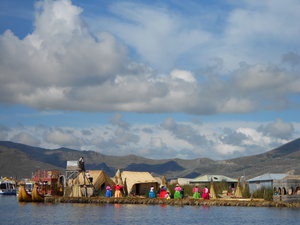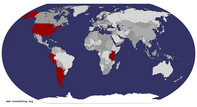Advertisement
Published: April 10th 2012

 Uros Islands
Uros Islands
A view from our boat as we approached the reed islands.Post breakfast we were picked up at our hostal by a van that took us to the boat dock. Our tour was the longest offered out of Puno. 2 days in which we would visit the Uros Islands and Amantani Islands (where we would stay with a host family) on the first day and Taquile Island on the second. The Uros Islands are about an hour boat ride from Puno, then 3.5ish hours to Amantani, 3ish hours to Taquile and 3ish hours back to Puno...although the boat was extremely slow so it wasn´t really that far between islands.
There were about 10 tourists on the trip, which unfortunately included a bratty British mom and the most bratty little kid we have ever been around. We spent the whole time trying to avoid them, they were awful. Ok, enough complaints, now to the good stuff.
Lake Titicaca is the worlds highest lake at 3,811 meters (12,500 feet). It is 160 meters long and 60% of it is in Peru, 40% in Bolivia. At its deepest, the lake is 284 meters deep. It has 63 islands with 5 accessable to tourists.
Our first stop on the trip was the Uros

 Uros Presentation
Uros Presentation
Floating base of the islands on the left and one of the spiritual tapestries on the right - featuring the puma.Islands and one island in particular. The islands are man-made from the reeds that grow in the lake and the islands actually float on the water with rope and pin anchors to keep them in place. There are about 3,000 Uros people that live on the islands. They moved out on to the lake to escape Spanish rule years ago. Because the islands are constantly decomposing, they have to replenish them with new reeds every 2 months. Each island contains a family with grandparents, parents and children living in 6 households.
After a presentation on the history and how the islands are built, one family showed us their meager home. A small 10x10ish foot reed hut with a double mattress and oddly enough a solar powered TV. The family was really friendly and spoke Spanish to us, despite it not being their native language. It was a little uncomfortable though because the women tried selling us the really cool tapestries they made. And even though we would have loved to get one, at $80 soles it was a little expensive.
On the island, Sarah won a necklace by guessing how deep the water was under the island. She
guessed 22 meters and it was 21. Pretty cool necklance. We briefly stopped at one other island (the tourist trap island where they try to sell more stuff) before heading to Amantani Island.
Overall it was really cool to visit the islands, but it was hard not to escape the influence tourism has had on their culture. I mean, a solar powered TV? It is such a catch 22. On one hand, we never would have seen such a cool place if it hadn´t become a huge tourist attraction. On the other hand, tourism has really had an impact on their society. Our guide talked about the tourism as a huge positive for the people, but I´m not so sure.
It was a beautiful day and the boat ride was nice. We could sit on the roof and enjoy the view. I had been rather sick lately so I tried to get some rest in the cabin.
Amantani Island is an actual island where fishing, farming and tourism are the basis of their economy. We were met at the dock by our host families and Sarah and I set off with Roberta, our host mom, for her
house. Roberta, and all the women who had come to met us at the dock, were all wearing matching clothes with a ´chopa head drape, black with embrodary at the bottom of colorful flowers that hung 6ish inches below the waist. Roberta was kind enough to keep the walk to a slow pace because at 12,500 feet and feeling under the weather it was rather challenging to climb the hillside to her house.
Everything is shared on Amantani Island. The food, work, etc. They even rotate the families that host the tourists.
At Roberta´s house, the highest on the hillside out of all the host families, we were introduced to her mother-in-law, Rosa. We were shown our room of two twin beds and an end table in between. The door was about 4 feet tall and the room wasn´t much more than 6 feet. There was a small window and wood plank floors that you could see the room below through the cracks. It had adobe-like walls and there was no electricity. The views from the house were amazing as we looked out across the lake and down to the step agriculture that covered the island. It was
a really lush green place with many flowers, crops and trees. Potatoes are their main crop and they grow all kinds. My favorite is the oka, a long skinny potato that tastes a little like corn. They have purple skinned potatoes as well. Quinua is a staple here as it only grows above about 4,000 meters. They have cows, goats and sheep that they use for cheese, wool, milk. The Amantani people are pretty much vegetarians due to the food they have access to.
After getting settled, Roberta rounded us up for lunch, her two cute little daughters sneaking a peak at us and giggling constantly. We walked in to a tiny little room with a table for the two of us. There was a side room where Rosa was cooking over a little fire. Roberta brought us soup first: quinua, potatoes, carrots and something green. Next was a plate with three small purple potatoes, two oka potatoes and a piece of fried goat cheese. We also had moonya tea, which is an herbal tea they use to treat headaches, stomach pain and for general health. Unfortunately it did not cure my sickness nor Sarahs headache.
Post lunch

 Mercedes
Mercedes
They call this boat their Mercedes. The smaller is the VW.we met up with the rest of the group and hiked up Pachatata (named after Father Earth). It was a fairly steep climb on a stone pathway. A funny man was offering taxi rides up to the tourists (via his horse). The altitude was really impacting people, but Sarah and I were ok.
At the top of the mountain we learned that the locals would climb there, walk around the ceremonial place three times, pick up 4 rocks and make 4 wishes. One for love, one for work, one for health and one for knowledge. They would then leave the three rocks at the ceremonial place. Sarah and I followed suit...to be determined if it worked.
After our hike we had dinner at Robertas house. And while it would have been rude, there is an image of Rosa that will be permanentely engrained in Sarah and my head. Rosa sat across from us staring down at her bowl of soup. Her filthy dirty feet rested on the cold dirt floor. Maybe Sarah can describe it better later. It was a very powerful moment. In that moment we realized just how poor this family really was and how generous

 Pig Island
Pig Island
Built from reedsthey were to show us in to their home and let us be part of their family for a night.
Post dinner we got dressed in the traditional clothing of the local people. Rosa, Robertas mom, walked us to the community center for the big fiesta. It was a fairly large, rectangular room with a band setting up at one end and all the tourists with their host families seated in chairs around the perimeter. There was one flourescent light bulb in the middle of the room providing some light. The band kicked in and the dance began. Rosa grabbed Sarah and I and taught us the basics. And by basics, I mean basics. Their style of dance involves holding hands with somebody and punching back and forth. It was almost like going to a workout class at the gym. And wow did I wish that was the kind of dance I had when I was in 8th grade. I mastered it in less than a minute.
As the dance wound on Sarah and I kept waiting for new dance moves to be introduced. Nope, not really. There were two slight variations, a straight armed twirly thing and

 Looking back at Uros
Looking back at Uros
A look back at the Uros Islands with the city of Puno visible in the backgroundwhen everybody would link arms and run around in a big circle in the room. Inbetween songs the entire room would sit back down. Then the next song would start and people would not get up right away, but wait a good 30 seconds in to the song. All in all the dance was a very cool experience.
Overnight there was a downpour of rain (soothing on the corrogated metal roof) and the next day the rain had not let up. We quickly ate breakfast (fried bread) and gave Rosa some fruit to say thanks for hosting us. We headed down to the dock to meet our boat. We thanked Roberta for having us and set off for Taquile Island, the last stop on the trip.
Taquile Island was fairly similar to Amantani, except it was a little more densely populated. We walked around for a bit and then our guide gave us a presentation at a restaurant. The presentation described the importance of weaving hats and belts and how the different colors of the clothing signified whether somebody was married or single and if they were single whether or not they wanted to meet a spouse.
Some of the group ate lunch at the restaurant, the rest of us continued to walk back to the boat. At about noon the whole group was back at the boat and we set off for Puno. 4 of the Taqule people joined us on the boat ride. We sat up on the roof with them for a little and observed the men knitting their belts. One of the men had a hat indicating he was married and a woman had a skirt indicating the same. The two younger people had clothing indicating they were single. For the 3 hour ride they mostly knitted and chewed on Cocoa leaves.
Song of the day - Madonnas Material Girl - being blared from the back of a mule carrying a large sack of potatoes
Advertisement
Tot: 0.071s; Tpl: 0.017s; cc: 12; qc: 28; dbt: 0.0275s; 1; m:domysql w:travelblog (10.17.0.13); sld: 1;
; mem: 1.1mb























Mike and Jill
non-member comment
The place you stayed looks EXACTLY like where we stayed : )